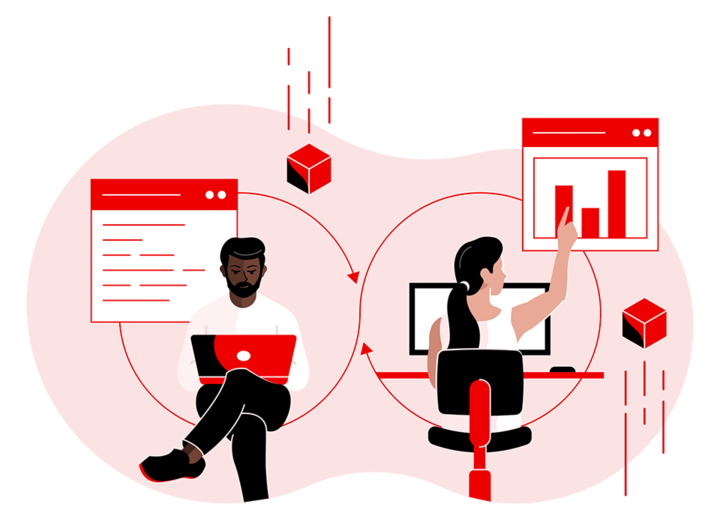To create high-performing teams, engineering leaders must embrace and enable a culture of continuous improvement. However, measuring improvement is often tied to individual performance indicators and vanity output metrics, and these measurements can teach all the wrong behaviors for high-performing teams.
While top engineering leaders should possess solid technical skills, driving an organization forward from an improvement perspective calls for a different skill set. Living by example and developing human skill sets that help leaders express the qualities of empathy and authenticity are what often separate good leaders from great ones.
I recently had the honor of hosting a discussion with “The New Faces of Continuous Improvement:” Dana Lawson, VP of engineering at GitHub, Kathryn Koehler, director of product engineering at Netflix, and Charity Majors, CTO of Honeycomb. We spent quite a bit of time discussing the role of engineering leadership and how these roles can enable continuous improvement among teams. Here are three ways these engineering leaders are creating change within their organizations and enabling high-performing teams to improve.
[ How strong is your EQ? See our related article: Emotional intelligence test: 5 self-evaluation tools for leaders. ]
1. Address socio-technical systems first
According to Charity Majors of Honeycomb, leaders must tend to the internal socio-technical systems first so that people can spend most of their time moving the business forward, not struggling in toil.
“People’s ability to shift swiftly and safely is 20 percent their own knowledge of algorithms and data structures and 80 percent the socio-technical system that surrounds them – the build systems, deployments, the processes around getting code out, etc.,” Majors notes. "If somebody joins your company, their ability to ship code is going to rise or fall to the level that your socio-technical system supports. How good they are at their job often only matters within those constraints.
"If technical leadership has one job, it is to tend to that socio-technical system so that team members can spend as much time as possible on priorities that move the business forward, not on trying to navigate or fix internal systems. Pay really close attention to those feedback loops and make them tight. Invest in the work where it makes sense – not just trying to fix everything and make it perfect, but look for where you can get really big wins and not have to reinvent the wheel.
“It turns out we have the benefit of knowing all the science that even just five to 10 years ago, we didn’t have. Read Accelerate, for example. There used to be a lot of ‘I think’ statements, and while it worked, it was very ‘cult-y’ and it was very based on osmosis. If you had been lucky enough to work with one of the best engineers in the world, then you kind of knew this stuff – it was all just contagious. Now, we have this freely available data, and we should be using it.”
2. Focus on diversity and coaching
Kathryn Koehler of Netflix says leaders can coach engineering team managers with a focus on improvement. According to her experiences, this applies to younger managers and seasoned management alike. Koehler puts a pretty big emphasis on staffing the team with exceptional, diverse candidates by bringing a wealth of experience, backgrounds, ethnographic, gender diversity, and more.
As a company that is taking on media giants, it’s so important to staff up on diversity so that Netflix has a lot of voices at the table, Koehler says. “It’s not just building in a monoculture. We bring in openness, accessible design, ease of use, and understanding how people work, and how we work around a more distributed workforce. If you don’t have these competing opinions at the table, how good are you?
“Furthermore, it is important to make your team look like your customer base and think like your customer base. Once you have people on a team you’re managing, leaders must ask, ‘how can I lead with empathy? How can I be inclusive? How can I create that environment of trust and mutual respect?’ That’s so important to leading any team, especially the fast-moving engineering teams of today. People need to be customer-obsessed in their roles. So, how do you empathize with the customer position and not despise them for always coming to you with problems? Instead, see it as, ‘Oh my gosh, we’re creating all these problems for these people. How do we go and solve them?’”
Koehler offers another good point for people that get thrust into a new leadership role: “Let’s assume that you were put into management because you’re really good at something. It’s not your job anymore to do the thing that you were really good at. It is your job to take the people that you are managing and mentoring and coaching and to coach them from a C to an A. You’re not going to help them by elbowing them out of the way.”
3. Set a positive tone
Setting the tone as a leader with regard to trust and being vulnerable is ideal for continuous improvement across the organization. “If your job is to align people, motivate, and understand the friction points, you really have to walk a mile in their shoes, and you have to find the outcomes that fix those problems,” says GitHub’s Dana Lawson.
One of the most important words in any leader’s vocabulary is responsibility, Lawson says. "I want people to come in and feel like this was worth their time. That should come with this stroke of positivity because what we know now – when you’re in the zone you’re happy – when you’re flowing, when you’re creating. You’re fixing problems, creating things, and helping enable humans. And if we keep our eye on that, then don’t we want to make it better for everybody?
"This is a critical point for any engineering leader to not only hear but understand. As leaders, we must set the tone for the rest of the team by believing in the possibilities and explain how any challenge can be overcome. Embracing the difficulty in the work doesn’t mean limiting the amount of time you can stop and smell the roses, but it embraces the opportunity to overcome problems.
"As engineering leaders, we must talk ad nauseum about raising the bar and how this mentality nurtures an exceptional engineering team. This usually only happens when leaders foster this mentality through shared learning, shared wins, team responsibility, rewarding the right behaviors individually for the whole team to benefit. Frequently reminding ourselves that it’s just a job, and it doesn’t really matter in the grand scheme of things, is part of the process.“What matters is these experiences that we’re having now, and I ask myself every day: Am I being a vector of joy? Because that’s what really matters.”
I couldn’t agree more.
[ Get exercises and approaches that make disparate teams stronger. Read the digital transformation ebook: Transformation Takes Practice. ]






